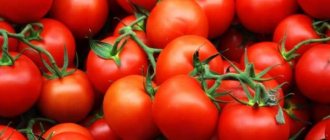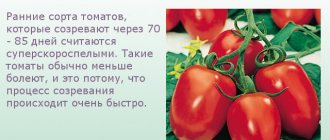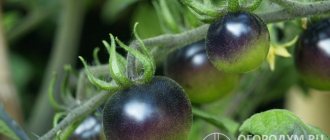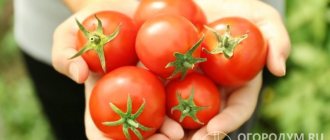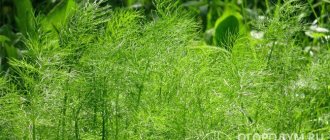Summer residents are actively purchasing seeds for the new season, but not everyone knows which variety to give their preference. It is especially difficult for beginners, and an important condition here is to understand what climate you live in. After all, you cannot plant the same tomatoes in different regions. A competent approach is important here. Today we will introduce you to the varieties of tomatoes for the Krasnodar Territory, both for open ground and for greenhouses. This fertile land is ideal for growing crops, but knowledge is still needed here.
Information about how to properly and where exactly varieties can be grown is very important. It is naive to believe that all tomatoes that could grow in open ground are suitable for a greenhouse, and vice versa.
general information
Tomato Kubanets is quite unpretentious; it prefers to grow in a mild climate, on the sea side, south of Tuapse. Here the conditions are most reminiscent of the homeland of tomatoes, sunny South America. Wild and semi-wild ancestors of modern varieties, well preserved to this day, are still found here.
The rest of the Krasnodar Territory is more arid, occupying more than 2/3 of the entire territory - about 70%. A conditional border can be drawn along the Kuban River, which divides the area into two unequal parts. The local conditions are more suitable for greenhouses than open vegetable growing. This will increase productivity and pay for the expensive design.
Given the high temperatures in summer, you should decide on the variety in advance. The foliage of the bushes should be dense, and the leaves themselves should be wide. That is, tomatoes for the Krasnodar region must grow inside the bush, securely covered with leaves from the scorching sun.
The intensity of sunlight can be controlled with polycarbonate blocks by installing them using a simple design over the beds.
Care
One of the most important positive qualities of standard tomatoes is their ease of care. Seedlings of these varieties practically do not stretch; by the time they are transplanted into open ground, the seedlings have a strong stem and a well-developed root system.
After transplantation, the bushes take root almost quickly and do not get sick. The leaves of standard tomatoes are large and corrugated, which increases the area for photosynthesis.
There are few stepsons, so most varieties and hybrids do not require stepsons. This makes caring for the bushes much easier.
During the growing season, standard varieties only need 3 feedings and periodic watering. In principle, nothing more needs to be done.
Agricultural technology
As you know, tomatoes can be grown:
- using seedlings;
- using the seedless method.
Both have an economic rationale. An arid climate requires the presence of seedlings and greenhouse conditions. Soft seaweed is native to tomato crops; here you can get by by sowing seeds in open beds.
Feeding frequency
The first fertilizing is done immediately after planting the seedlings. This is necessary to reduce the adaptation period during transplantation. For several days the bushes will get used to the new conditions and chemical composition of the soil.
The second is produced after the first small tomatoes appear. For intensive growth, the plant needs adequate nutrition. The time after landing here varies widely. Depends on the condition of the bushes, variety, and conditions of detention.
Next, you need to grow an excellent harvest, which will also require strength. The frequency at this stage is 10 – 15 days. It all depends on the depletion of the soil.
Seedlings need feeding most of all, require a greenhouse climate, and are sensitive to watering and lighting. The seeds are immediately planted in the prepared soil, but there are stages of fertilizing that are recommended to be followed:
- The first is after the appearance of one or two full-fledged leaves.
- The second is after the dive.
- The third is before disembarkation.
Often seedlings are grown in greenhouses, directly in the garden plot. This facilitates the transportation process and makes it possible to carry out the hardening procedure before planting.
In some cases, to protect bushes from the sun, heat-resistant polycarbonate blocks or special filters are used that scatter sunlight, reduce the intensity of harmful ultraviolet radiation, and transmit a certain color spectrum. They consist of heat-resistant materials that do not change their properties over time.
Compliance with certain rules of agro-industrial production allows you to obtain excellent tomatoes New Kuban or another variety. All tomatoes are adapted for the difficult climatic conditions of the region and, with proper care, delight their owners with juicy, tasty fruits.
The soil
The soil should be light and nutritious. A mixture of humus, sand and earth is ideal. Usually the soil is prepared in late autumn, spreading humus throughout the area. During the winter and part of spring it rests, some of the nutrients are absorbed into the soil with the help of melt water. After this, complex fertilizers are added and dug up. All that remains is to choose the right time to plant seedlings, care for them and wait for the harvest.
The soil characteristics in the Krasnodar region must be taken into account when planting. Arid steppe lands consist of carbonate, leached chernozems. Mineral feeding is needed here.
Complex fertilizers are usually used - the risk of overfeeding the plant with a single element is reduced. Sometimes there is a need for spot feeding of tomato varieties for the Krasnodar Territory - open ground allows the application of fertilizers using liquid or dry methods.
For these purposes they usually use:
- superphosphate (phosphorus content 20%) or double superphosphate (45%);
- potassium nitrate;
- urea
To plant bushes in such soil, it is pre-treated with all three types of fertilizers. The recommended ratio is 1:1:1. After the first fruits appear, the proportion is changed - 3:9:1.
The proportional composition of the fundamental elements in Krasnodar and the region is selected individually by region. The soil is different everywhere; after harvesting, its composition changes greatly. The increase in the amount of potassium and phosphorus during fruit formation is due to the increased need of the crop for these elements. Fertilizer application schedules can be considered as zoned - their composition varies over the entire area of the region.
The main thing is not to overfeed the plant. Increased levels of nitrogen, potassium, phosphorus, and magnesium lead to diseases, decreased yields, and slower growth.
Foliage is a kind of indicator of increased concentration of elements:
- magnesium, phosphorus - leads to blackening of leaves along the edges;
- nitrogen - yellowing;
- potassium - development of necrosis;
- calcium is a growth stimulator; the crop cannot cope with such a load and dies from a lack of other elements.
See also
Description of the tomato variety Slavic masterpiece, plant careRead
Resistance to infections and adverse conditions
This indicator is associated with the whimsicality of the fruits, their immunity, as well as how much they need care and attention. We will not dwell on this point for long, but will only note that all greenhouse varieties are not particularly resistant, and therefore require careful and constant care.
To summarize, it can be noted that there are a lot of varieties of tomatoes. That is why it is difficult to say which one is better or worse
It is important that every summer resident who is planning to grow tomatoes, before planting them, understands what exactly he expects from his fruits
Summer residents are actively purchasing seeds for the new season, but not everyone knows which variety to give their preference.
It is especially difficult for beginners, and an important condition here is to understand what climate you live in. After all, you can’t plant the same tomatoes in different regions.
A competent approach is important here. Today we will introduce you to the varieties of tomatoes for the Krasnodar Territory, both for open ground and for greenhouses. This fertile land is ideal for growing crops, but knowledge is still needed here.
Seedling
Every gardener before the start of the season wonders when to plant tomatoes. The usual period is 40 – 45 days before the start of disembarkation. When growing, they strive to create a plant that meets certain requirements:
- color - rich dark green;
- strong elastic leg;
- the number of fully formed leaves is 5 – 6;
- height - at least 20 - 30 cm;
- appearance is fresh.
You can use a planting calendar and decide when to plant tomato seedlings. It is also called lunar. It is believed that seedlings grow better when the moon is rising. Why is this happening? Perhaps the plant receives more moonlight or is exposed to gravitational fields.
Experienced gardeners plan in advance the time to plant tomatoes and study the weather forecast.
The main risks associated with its growth:
- You can get overgrown seedlings. In this case, it becomes unsuitable for planting. Before sowing tomatoes for seedlings, you need to plan fertilizing. When there is an overdose of beneficial elements, the sprouts grow too quickly. The stem turns out thin, unable to hold foliage and ovaries.
- Lack of lighting can cause the plant to grow rapidly. Usually in Kuban when the season begins, the weather is sunny. When growing at home, nuances are possible. To prevent this from happening, it is recommended to use artificial lighting. This is done using specially installed LED lamps in red, green, and blue colors. It is necessary that the light washes the plant - in this case, a thick stem and elastic foliage are formed.
- Usually they take a supply of three to ten days from the moment when the seeds are sown. This is done to check germination - low-quality seeds take a long time to produce the first shoots. Healthy, strong seeds produce the first shoots already on the third day after planting.
To check germination, your favorite or best tomato varieties must first be checked. Seed material is poured into warm water and waited for at least 10 minutes.
Healthy seeds will quickly become saturated with water and settle at the bottom of the container. Hollow ones will remain on the surface. They need to be sorted. It is not recommended to use hollow seeds.
What tomatoes to grow in open ground
Breeders have developed varieties and hybrids of accelerated ripening. Plants produce their harvest in one or two waves. This property allows you to “escape” late blight.
The gardener should pay attention to the use of fruits. Salad tomatoes are large. Their number on the bush is insignificant
Plants with a universal purpose are more productive. But they lag behind in taste: lower sugar content, rougher skin
Their number on the bush is insignificant. Plants with a universal purpose are more productive. But they lag behind in taste: lower sugar content, rougher skin.
Tomato Volgograd early ripening 323
Agronomists have created a new series: “Garden Abundance”. The variety represents a line of tomatoes. The plant is adapted to open ground. The fruits ripen 95-100 days after the loops appear. It is distinguished by the friendly ripening of berries. “Goes away” from late blight.
The bushes are low: they stretch up to 45 cm. They are distinguished by strong foliage. No shaping or garter required.
Fruit characteristics:
- spherical shape;
- smooth to the touch;
- slightly ribbed at the top;
- color bright red;
- thick skin;
- taste sweet and sour;
- berry weight up to 100 g;
- There are up to 5 fruits in a brush.
Gardeners give good reviews about the variety. The taste and speed of ripening are pleasing. People begin to feast on tomatoes as early as July 15th.
Tomato Azhur F1
SeDek breeders have developed a mid-early hybrid. The first fruits appear 110-115 days after germination.
Hybrid characteristics:
- determinate bush (reaches 0.9 m);
- the plant is powerful, with a thick stem;
- dark green leaves;
- internodes are short;
- the plant forms up to 5 clusters on the stem;
- each contains 5 fruits.
Those who planted it know: Openwork is resistant to TMV, verticillium, fusarium, and rot. With proper care it gives a yield of up to 10 kg/sq.m.
The fruits have the following properties:
- weighing up to 200 g;
- bright red color;
- dense pulp;
- sugar content;
- sweet taste;
- 6 chambers with small seeds;
- glossy dense skin.
Gardeners recommend the universal use of fruits. Fresh tomatoes are delicious, the skin does not crack. Juices, pastes, and ketchups have a sweet taste.
The keeping quality of tomatoes is pleasantly surprising. They are stored in the room for more than 35 days. Tomatoes are easy to transport to the place of sale or storage.
Tomato Robinson F1
Chelyabinsk agronomists have created the Robinson hybrid. It is perfect for growing in open ground in the Vitebsk region.
Distinctive features of the plant:
- determinate hybrid (less than 1.2 m);
- early ripening period (from loops to first fruits - 90 days);
- the leaves resemble those of a close relative, the potato;
- requires the formation of a bush and garter to a support.
In the Urals, gardeners appreciated Robinson. In 2022, the hybrid became the most purchased product.
In a short summer with changeable weather, Robinson produces a stable harvest. The fruits ripen together. After harvesting, the beds are cleared and late blight is not observed.
Tomatoes delight with the following characteristics:
- bright crimson color;
- sweet taste;
- weighing up to 300 g;
- slightly flattened round shape;
- weak ribbing at the stalk;
- juicy pulp;
- easy separation from the stalk;
- dense, rough skin.
Gardeners celebrate the friendly yield of the harvest. Large fruits are eaten whole, small ones are rolled into jars, salted, and pickled. The raspberry color and sweet taste distinguish canned food.
Tomato Slivovka
Another variety with early ripening. Gives a harvest in open ground in any weather. Characteristics of Slivovka:
- determinate bush (0.4 m);
- You can enjoy the fruits 100 days after germination;
- yield 8 kg/sq m (with proper agricultural technology);
- friendly ripening of tomatoes;
- does not require shaping, pinching, or gartering;
- does not suffer from blossom end rot or septoria;
- sets fruit in any weather.
Gardeners like strong, stocky seedlings. Young bushes do not stretch.
What delights the fruits of Slivovka:
- plum shape with a sharp “spout”;
- dense fleshy pulp;
- weighing up to 120 g;
- sour taste;
- resistance to cracking.
Gardeners like the transportability of Slivovka. Berries look original in assorted vegetables. The skin is not damaged, the pulp does not spread.
Varieties for the Krasnodar region
Many varieties of tomatoes for open ground tolerate short-term drops in temperature well. At the same time, growth slows down, but the yield is preserved. This feature is used for growing late varieties. They try to take full advantage of autumn time. The most attractive temperature for tomato plants is +18 – 25 degrees.
Early:
- Crimson Giant;
- Chinese;
- Mystery;
- Anastasia;
- Persimmon;
- Firework.
See also
Description of the tomato variety Mishka in the north, features of cultivation and careRead
Average ripening period:
- Alpinog;
- Giant Novikova;
- Digitomandra;
- tomato Kubanets f1;
- Russian giant;
- Barin F1;
- Bourgeois F1.
Late ripening period:
- brindle;
- Golden Drop;
- Giant of the East;
- Lemon-Liana;
- Long Keeper;
- Do Carao;
- Bull's heart.
Many of these varieties are sweet in taste, with a slight sourness. There are also complex hybrids, such as Barin F1 or Bourgeois F1. These are the most popular, best varieties of tomatoes for the Stavropol and Krasnodar Territories.
Cherry
This group includes the following varieties:
- Brusiki. These are dwarf sweet tomatoes.
- Lemon. The fruits are light yellow in color and do not taste sweet.
- Green pearl. It has a sweet and sour taste and is orange in color.
- Noon. This variety has medium-sized and rounded fruits. Color orange.
- Sunny bunny. Large cherry variety. Their color is bright yellow, and their shape is slightly elongated.
- Sangella. This short hybrid is early ripening. The bushes are tall and the fruits have a sweet taste.
- Chocolate pearls. A hybrid that bears fruit before frost. Their skin is thick and brown in color.
On the video - varieties of tomatoes in open ground:
Features of growth
Each culture has individual growth characteristics, which boil down to the implementation of general recommendations. This will help you get a good harvest: growing tomatoes requires special attention. The process is quite troublesome, the culture requires a lot of time to care for.
Watering tomatoes in a greenhouse or in open ground should be done in the evening or in the morning. It is not recommended to use sprinkling from morning to afternoon. The hot afternoon sun will quickly heat the water on the leaves, which can damage their delicate structure. Dust or dirt accumulates on the leaves; to improve photosynthesis processes, you can sometimes pamper the plant with sprinkling.
It is recommended to water at the root. The hot sun and warm climate that characterize the Krasnodar region justify the use of precautions. Sometimes the watering scheme is complicated. Plastic pipes with special sprayers are laid along the entire length of the beds. With this method of watering, each bush receives its own portion of water.
Fertilizing is done 3-4 times per season, it all depends on the condition of the Kuban soil. The frequency depends on the periods of plant growth.
What to pay attention to when choosing tomato seeds
Summer residents usually choose tomatoes based on some important criteria. They are different, each variety has its own taste, purpose and amount of harvest.
Basic requirements for seeds that experienced gardeners usually pay attention to:
- Immunity and resistance to various tomato diseases.
- Abundant harvest. Some varieties are not designed for this.
- Why tomatoes are grown: they are used in salad form, for cutting, pickled or salted, to make healthy tomato juice.
- Taste: tomatoes can be sour, sweet, sour-sweet, bitter.
- Good company, reviews.
Tomatoes are also divided into varieties:
- Low or tall bushes;
- Large fruits, medium weight and small mini ones;
- For greenhouses or open ground;
- Shrubs with limited growing point or not;
- The taste is tomato or fruity;
- Color. There are different colors and shades: red, green, yellow, even black;
- Early, middle or late.
If a summer resident is in doubt about choosing self-pollinating varieties, then you can study a lot of useful information about them on the Internet. Since almost all of them have excellent disease resistance, they are not afraid of temperature fluctuations, frequent spontaneous weather changes, they bring an excellent harvest, and are pollinated naturally.

